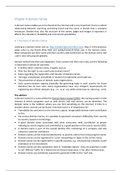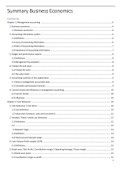A domain name enables you to be found on the internet and is very important: there is a direct
relationship between searching and being found and the name or brands that a company
introduces. Besides that, also the structure of the names, pages and images is important: it
affects the indexation, findability and commercial possibilities.
4.1 The basis of domain names
Looking at a domain name such as: http://waldorfastoria3.hilton.com: http:// is the protocol,
www refers to the World Wide Web and waldorfastoria3.hilton.com is the domain name.
Most companies use their name and their country code (extension) as the domain name, but
.com is also very popular globally.
Domain names have their own legislation. Every country has their own rules, but the following
is important in almost all countries:
• It defines what a domain name is legally seen as.
• Who has the right to use a particular domain name?
• Rules regarding the registration and transfer of domain names.
• The legal complexities and pitfalls in relation to trademarks and trade law.
• The prevention of abuse of domain name registrations.
• Each country-domain registry (basically the governing body in each country for those
domains) has its own rules. Some organisations have very stringent requirements for
registering one of their domains (e.g. .cn, .ca or .us), while some have no rules (e.g. .com).
The address
A domain (name) is a name within the Domain Name System (DNS): the naming system on the
internet in which computers such as web servers and mail servers can be identified. The
domain name is the ‘address’ where you can find something on the internet; it links to a
location where content can be found. A domain name is of importance for:
• Traceability by consumers on the internet; a good, recognizable domain name contributes
to this.
• Via various domain names, it is possible to approach consumers differently from country
to country, based on technology.
• A good domain name associated with what consumers seek, contributes to proper
indexing by search engines and contributes to a good position in the search results (SEO).
• A domain name is part of the overall identity (PR, marketing) of a company and also
enhances customer confidence.
• Domain names can be reserved defensively: to prevent others from (mis)using the name.
• Domain names can be registered to ‘catch’ misspellings or typos in the correct name.
• Domain names can be registered for a specific purpose, e.g. a (temporary) initiative, a joint
promotion or for recruitment.
• Domain names are also sometimes seen as ‘tradeable objects’: they are acquired in order
to sell. Without traffic (to a linked site) and brand awareness, it has often limited value.
• Domain names are sometimes acquired to generate traffic to the ‘real’ site.
, o Traffic is determined by the number of visitors and the number of pages they visit.
By registering good domain names, you can optimize the search for potential
customers. These sites may have factual content or just redirect to the original site.
There are three levels of domain names. Most domain names consist of two or three parts.
For example: http://workforce.shell.com:
• Level 1 Top-level domain name com
• Level 2 Second level domain name shell
• Level 3 Third level domain name workforce
Level 1 Top-level domain name
Top-level domain names (also first level domain names) are abbreviated as TLDs. They are
fixed for the entire internet by the ICANN. Until 2013 there was a ‘permanent’ list of
extensions, but now the list is open and there are added hundreds of new extensions yearly.
There are six types of TLDs that are explained below:
Level 1 type 1 Geographical TLD (ccTLD)
CC stands for the two-letter country code that every country has. Many US websites use .com
instead of .us. The name does not have to have a direct relation with the chosen ccTLD. The
most used ccTLDs are .tk (Isla of Tokelau, free extension), .de, .cn and .uk.
Level 1 type 2 Type of organisation, generic TLD (gTLD)
This kind of TLD shows the type of organisation. These are the most popular ones:
• .com = commercial à An open (and the ‘main) TLD that everyone can register.
• .org = organisation à Also an open TLD, intended for use by non-profit organisations.
• .net = network à Also an open TLD, intended for use by domains pointing to a distributed
network of computers, or ‘umbrella’ sites that act as the portal to a set of smaller websites.
• .int = international organisations à Strictly limited to organisations, offices and programs
which are endorsed by a treaty between two or more nations.
• .edu = US higher education à Limited to specific educational institutions (not only US).
• .gov = US national and state government agencies à Limited to governmental entities and
agencies in the US.
• .mil = US military
Level 1 type 3 Enterprises and commercial TLDs
Since 2013 it is possible to claim your own company name or brand as a TLD. These are not
easy to claim and are also very expensive (around €200.000,- plus an annual fee). Examples
are .bmw and .marriot.
Level 1 type 4 City and cities TLDs
It is also possible to claim a city name as a TLD (but are also expensive). An example is .berlin.
Level 1 type 5 Pure generic TLDs
It is hard to register these names (such as .beer or .vine) because of (branding) laws.
Level 1 type 6 Custom TLDs: TLDs in other alphabets
Since 2014 it is possible to capture gTLDs in Chinese, Arabic and Russian.
, TLDs are only registered by larger companies as they have high costs and technological issues.
Mostly, companies register their names in several existing TLDs (also in .com) in order to
enhance their position in search engines and to prevent others from (mis)using it. Generally,
the company’s own country code and the key country codes where customers come from are
interesting to buy.
Level 2 Second level domain names
Looking at the domain name buas.nl, the second level domain name is ‘buas’. It is mostly the
name of the company, but it can also be a brand name, phrase or slogan. Temporary domain
names (and also non-temporary) can redirect visitors to a specific page on the main website.
There are a few requirements for second level domain names: spaces are not allowed and the
length must be between 2 and 62 characters. Most domain names cost 20-50 euros per year.
There are intermediaries via which companies can register a domain: they are called registrars
and are companies such as Hostnet.nl and One.com. The registrars regulate the reservation
of the TLD names to the administrator of the extension, from the (central) register. There is
only one administrator per TLD and this body is called the registry. For the TLD .nl SIDN, the
Foundation for Internet Domain Registration in the Netherlands, regulates this and for .com
it is Verisign and for .de Denic.
Level 3 Third level domains
The holder of the second level domain name can create and manage an unlimited number of
third level domain names. It mostly replaces the www. Examples are: staff.buas.nl and
guest.buas.nl: ‘staff’ and ‘guest’ are the third level domains. These domains do not have to be
externally registered and will not lead to extra costs.
4.2 Who manages domain names?
The ICANN (Internet Corporation for Assigned Names and Numbers) is the umbrella
organisation that is responsible for the Domain Name System at the top level. It became an
entire industry when they started to introduce much more TLDs that sometimes cost a lot of
money. For example, ‘holiday.thomascook.com’ could now become ‘holiday.thomascook’.
Not all extension became a success, but some such as .tk and .tv were because they were free
to apply for second level domain names – but it also led to abuse of these extensions.
.NL
In 2018, there were about 6.1 million domain names registered under .nl: over 70% was used
for business. Only 62% of these domain names was linked to a website, so there are many
more domain names than there are websites. .nl was the first TLD outside the US and
nowadays is the 9th most used TLD worldwide.
4.3 Which name would you reserve?
It is necessary for a domain name to have a clear link with the company name and it should
be easy to remember and not needed to be spelled out. It should not been registered already
within the most logical country code as well as .com and within the most logical spellings. It
should not lead to misunderstandings, sounds reliable and not be in conflict with other names.












